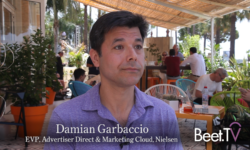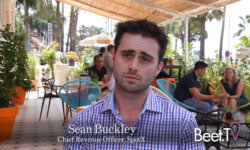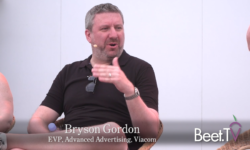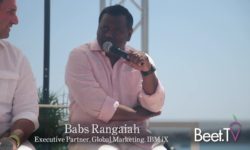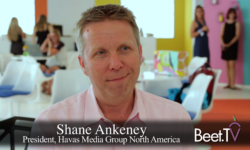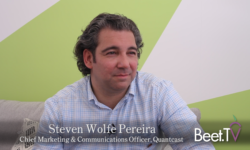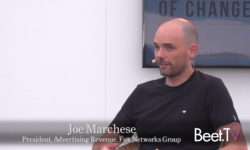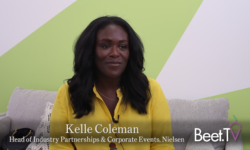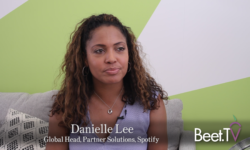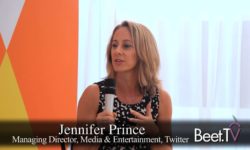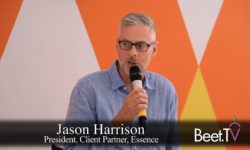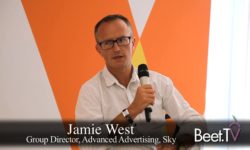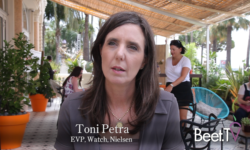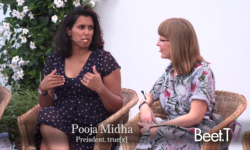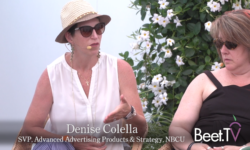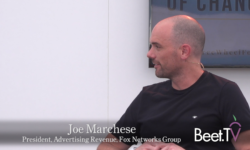CANNES – How does a huge marketer like Nissan convince its procurement people to explore new, non-traditional ways of reaching audiences and measuring those efforts? “We have this kind of internal joke that right now we have more pilots than American Airlines,” is how Allyson Witherspoon, Nissan’s GM for Global Brand Engagement, explained it.
At the recent Cannes Lions International Festival of Creativity, Witherspoon was one of four panelists who discussed new video ad formats and how creative and media agency professionals are working more closely together to build stories relevant to specific audiences. It was one of several discussions at Cannes under the auspices of the FreeWheel Forum on the Future of Television.
Moderator Matt Spiegel of MediaLink kicked things off by asking “How much more will you pay for a non-standard ad?”
Responded true[X] President Pooja Midha, “It’s how much more will you pay for impact. Non-standard, who cares?”
That’s where things got complicated, as Witherspoon explained. “It’s difficult, because sometimes you don’t always know what the outcome is going to be. Within this campaign or within each kind of percentage of always on, what amount of that is going to be something that you’re going to be testing.”
Which is where Nissan’s “pilots” come in and how testing is needed to help change the thinking within procurement. “Once you take the results from that, how do you actually start to scale that? I think that’s when you can start to advance the financial discussion, once you’re able to show that impact across, in the case of Nissan, all of our models, across all of our markets, that’s a very powerful discussion to have,” said Witherspoon.
Wavemaker’s Amanda Richman said the test-and-learn approach also needs an activation plan. “So as you’re presenting a learning road map, you actually can say, ‘if this works we’re going to scale immediately.’ We’re not going to wait and have another committee meeting, it’s not going to be three months. Turn on a dime and then roll on to the next test.”
Along the way, people on both the creative and media side need to come together more than ever, said John Osborn, CMO, OMD USA, because media plans traditionally have been built in a process wherein storytelling has been relegated to creative agencies.
“There’s a gap in between, which is story building, and I think it’s amazing what happens when you get tight teams sitting together, working together from the onset, as opposed to the traditional iterative process where sometimes media comes in late in the game,” Osborn said.
He described the process with Nissan, TBWA and OMD “literally welded together at the hip, working on which types of data will better inform the right kinds of storytelling.”
true[X] does real-time creative optimization for Nissan as it simultaneously measures real-time brand lift. “We launch with one version of an engagement, and as we see the data coming back we’re able to actually build with Nissan and its agency a more elaborate version, or a version that lets you go deeper or let’s us hone in on what we see really lifting,” said Midha.
Spiegel wanted to know whether creative personalization is right for all brands, particularly the biggest ones with the widest target audiences.
“One of the things we’ve seen across the tens of thousands of engagements we’ve built is that strong, persistent branding, even for very, very well advertised brands, is really important in actually driving results for them,” Midha said.
Richman related that one of Wavemaker’s clients describes its target audience as “anyone with a mouth.” Still, such a brand might need to achieve relevance with a new generation of consumers or could be missing opportunities for frequency or selling across its whole portfolio.
“A level of personalization may not be one hundred segments, but looking it from the lens of two or three it will drive the business forward,” Richman said.
The panelists agreed that campaign measurement will continue to be one of the biggest challenges, given cross-platform content consumption. The fact that advertisers and publishers alike recognize this and want to change old habits, there are fundamental barriers that will take time to overcome.
“Right now, to launch anything, for example inside of CTV, which is such an important environment, it’s not one platform. It’s a bunch of different devices that are all built on different code bases. It’s not simple,” said Midha.
As the discussion shifted to things like total ratings points and sound media strategies, Osborn summed things up by observing “Sometimes, we get so wrapped up in the media jargon there’s a great brilliance in just thinking as a human would think.”
This video is from a series of videos and sessions produced in partnership with FreeWheel at Cannes 2018 as part of the FreeWheel Forum on the Future of Television. You can find more videos from this series here.






